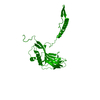+ Open data
Open data
- Basic information
Basic information
| Entry | Database: PDB / ID: 6s2o | ||||||
|---|---|---|---|---|---|---|---|
| Title | Granulovirus occlusion bodies by serial electron diffraction | ||||||
 Components Components | Granulin | ||||||
 Keywords Keywords |  VIRAL PROTEIN / granulovirus / occlusion body / serial crystallography VIRAL PROTEIN / granulovirus / occlusion body / serial crystallography | ||||||
| Function / homology |  Polyhedrin / Polyhedrin /  Polyhedrin / viral occlusion body / structural molecule activity / Polyhedrin / viral occlusion body / structural molecule activity /  Granulin Granulin Function and homology information Function and homology information | ||||||
| Biological species |   Cydia pomonella granulosis virus Cydia pomonella granulosis virus | ||||||
| Method |  ELECTRON CRYSTALLOGRAPHY / ELECTRON CRYSTALLOGRAPHY /  electron crystallography / electron crystallography /  cryo EM / Resolution: 1.6 Å cryo EM / Resolution: 1.6 Å | ||||||
 Authors Authors | Buecker, R. / Mehrabi, P. / Schulz, E.C. / Hogan-Lamarre, P. | ||||||
 Citation Citation |  Journal: Nat Commun / Year: 2020 Journal: Nat Commun / Year: 2020Title: Serial protein crystallography in an electron microscope. Authors: Robert Bücker / Pascal Hogan-Lamarre / Pedram Mehrabi / Eike C Schulz / Lindsey A Bultema / Yaroslav Gevorkov / Wolfgang Brehm / Oleksandr Yefanov / Dominik Oberthür / Günther H Kassier / ...Authors: Robert Bücker / Pascal Hogan-Lamarre / Pedram Mehrabi / Eike C Schulz / Lindsey A Bultema / Yaroslav Gevorkov / Wolfgang Brehm / Oleksandr Yefanov / Dominik Oberthür / Günther H Kassier / R J Dwayne Miller /   Abstract: Serial X-ray crystallography at free-electron lasers allows to solve biomolecular structures from sub-micron-sized crystals. However, beam time at these facilities is scarce, and involved sample ...Serial X-ray crystallography at free-electron lasers allows to solve biomolecular structures from sub-micron-sized crystals. However, beam time at these facilities is scarce, and involved sample delivery techniques are required. On the other hand, rotation electron diffraction (MicroED) has shown great potential as an alternative means for protein nano-crystallography. Here, we present a method for serial electron diffraction of protein nanocrystals combining the benefits of both approaches. In a scanning transmission electron microscope, crystals randomly dispersed on a sample grid are automatically mapped, and a diffraction pattern at fixed orientation is recorded from each at a high acquisition rate. Dose fractionation ensures minimal radiation damage effects. We demonstrate the method by solving the structure of granulovirus occlusion bodies and lysozyme to resolutions of 1.55 Å and 1.80 Å, respectively. Our method promises to provide rapid structure determination for many classes of materials with minimal sample consumption, using readily available instrumentation. | ||||||
| History |
|
- Structure visualization
Structure visualization
| Movie |
 Movie viewer Movie viewer |
|---|---|
| Structure viewer | Molecule:  Molmil Molmil Jmol/JSmol Jmol/JSmol |
- Downloads & links
Downloads & links
- Download
Download
| PDBx/mmCIF format |  6s2o.cif.gz 6s2o.cif.gz | 75.9 KB | Display |  PDBx/mmCIF format PDBx/mmCIF format |
|---|---|---|---|---|
| PDB format |  pdb6s2o.ent.gz pdb6s2o.ent.gz | 47.7 KB | Display |  PDB format PDB format |
| PDBx/mmJSON format |  6s2o.json.gz 6s2o.json.gz | Tree view |  PDBx/mmJSON format PDBx/mmJSON format | |
| Others |  Other downloads Other downloads |
-Validation report
| Arichive directory |  https://data.pdbj.org/pub/pdb/validation_reports/s2/6s2o https://data.pdbj.org/pub/pdb/validation_reports/s2/6s2o ftp://data.pdbj.org/pub/pdb/validation_reports/s2/6s2o ftp://data.pdbj.org/pub/pdb/validation_reports/s2/6s2o | HTTPS FTP |
|---|
-Related structure data
| Related structure data |  10091MC  6s2nC M: map data used to model this data C: citing same article ( |
|---|---|
| Similar structure data |
- Links
Links
- Assembly
Assembly
| Deposited unit | 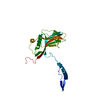
| ||||||||||
|---|---|---|---|---|---|---|---|---|---|---|---|
| 1 | x 12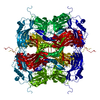
| ||||||||||
| Unit cell |
|
- Components
Components
| #1: Protein |  / Matrix protein / Matrix proteinMass: 29378.559 Da / Num. of mol.: 1 Source method: isolated from a genetically manipulated source Source: (gene. exp.)   Cydia pomonella granulosis virus (isolate Mexico/1963) Cydia pomonella granulosis virus (isolate Mexico/1963)Strain: isolate Mexico/1963 Production host:   Cydia pomonella granulosis virus (isolate Mexican) Cydia pomonella granulosis virus (isolate Mexican)References: UniProt: P87577 |
|---|---|
| #2: Water | ChemComp-HOH /  Water Water |
-Experimental details
-Experiment
| Experiment | Method:  ELECTRON CRYSTALLOGRAPHY ELECTRON CRYSTALLOGRAPHY |
|---|---|
| EM experiment | Aggregation state: 3D ARRAY / 3D reconstruction method:  electron crystallography electron crystallography |
- Sample preparation
Sample preparation
| Component | Name: Cydia pomonella granulosis virus (isolate Mexican) / Type: VIRUS / Entity ID: #1 / Source: NATURAL |
|---|---|
| Source (natural) | Organism:   Cydia pomonella granulosis virus (isolate Mexican) Cydia pomonella granulosis virus (isolate Mexican) |
| Details of virus | Empty: NO / Enveloped: NO / Isolate: OTHER / Type: VIRION |
| Buffer solution | pH: 7 |
| Specimen | Embedding applied: NO / Shadowing applied: NO / Staining applied : NO / Vitrification applied : NO / Vitrification applied : YES : YES |
Vitrification | Cryogen name: ETHANE |
-Data collection
| Experimental equipment |  Model: Tecnai F20 / Image courtesy: FEI Company |
|---|---|
| Microscopy | Model: FEI TECNAI F20 |
| Electron gun | Electron source : :  FIELD EMISSION GUN / Accelerating voltage: 200 kV / Illumination mode: OTHER FIELD EMISSION GUN / Accelerating voltage: 200 kV / Illumination mode: OTHER |
| Electron lens | Mode: DIFFRACTION / C2 aperture diameter: 5 µm / Alignment procedure: OTHER / C2 aperture diameter: 5 µm / Alignment procedure: OTHER |
| Specimen holder | Cryogen: NITROGEN Specimen holder model: GATAN 626 SINGLE TILT LIQUID NITROGEN CRYO TRANSFER HOLDER Temperature (max): 100 K / Temperature (min): 93 K |
| Image recording | Average exposure time: 0.01 sec. / Electron dose: 4.7 e/Å2 / Film or detector model: OTHER / Num. of diffraction images: 32000 / Num. of grids imaged: 1 |
| Image scans | Sampling size: 50 µm / Width: 1536 / Height: 512 |
| EM diffraction | Camera length: 2580 mm / Tilt angle list: 0 |
| EM diffraction shell | Resolution: 10→1.55 Å / Fourier space coverage: 1 % / Multiplicity: 1 / Num. of structure factors: 1 / Phase residual: 1 ° |
| EM diffraction stats | Fourier space coverage: 100 % / High resolution: 1.6 Å / Num. of intensities measured: 9650574 / Num. of structure factors: 23422 / Phase error: 13.64 ° / Phase residual: 1 ° / Phase error rejection criteria: 0 / Rmerge: 0.093 / Rsym: 0.093 |
| Reflection | Biso Wilson estimate: 16.07 Å2 |
- Processing
Processing
| Software |
| ||||||||||||||||||||||||||||||||||||||||||||||||||||||||||||||||||||||
|---|---|---|---|---|---|---|---|---|---|---|---|---|---|---|---|---|---|---|---|---|---|---|---|---|---|---|---|---|---|---|---|---|---|---|---|---|---|---|---|---|---|---|---|---|---|---|---|---|---|---|---|---|---|---|---|---|---|---|---|---|---|---|---|---|---|---|---|---|---|---|---|
| EM software |
| ||||||||||||||||||||||||||||||||||||||||||||||||||||||||||||||||||||||
| EM 3D crystal entity | ∠α: 90 ° / ∠β: 90 ° / ∠γ: 90 ° / A: 103.2 Å / B: 103.2 Å / C: 103.2 Å / Space group name: I23 / Space group num: 197 | ||||||||||||||||||||||||||||||||||||||||||||||||||||||||||||||||||||||
CTF correction | Details: Data reduction and structure solution using X-ray crystallography codes (CrystFEL, Phaser, cctbx.xfel, Coot) Type: NONE | ||||||||||||||||||||||||||||||||||||||||||||||||||||||||||||||||||||||
3D reconstruction | Resolution: 1.6 Å / Resolution method: DIFFRACTION PATTERN/LAYERLINES / Symmetry type: 3D CRYSTAL | ||||||||||||||||||||||||||||||||||||||||||||||||||||||||||||||||||||||
| Atomic model building | PDB-ID: 5G0Z Pdb chain-ID: A / Pdb chain residue range: 6-248 | ||||||||||||||||||||||||||||||||||||||||||||||||||||||||||||||||||||||
| Refinement | Resolution: 1.55→72.97 Å / SU ML: 0.1976 / Cross valid method: FREE R-VALUE / σ(F): 1.33 / Phase error: 21.1215 Stereochemistry target values: GeoStd + Monomer Library + CDL v1.2
| ||||||||||||||||||||||||||||||||||||||||||||||||||||||||||||||||||||||
| Solvent computation | Shrinkage radii: 0.9 Å / VDW probe radii: 1.11 Å / Solvent model: FLAT BULK SOLVENT MODEL | ||||||||||||||||||||||||||||||||||||||||||||||||||||||||||||||||||||||
| Displacement parameters | Biso mean: 19.29 Å2 | ||||||||||||||||||||||||||||||||||||||||||||||||||||||||||||||||||||||
| Refine LS restraints |
| ||||||||||||||||||||||||||||||||||||||||||||||||||||||||||||||||||||||
| LS refinement shell |
|
 Movie
Movie Controller
Controller





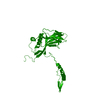

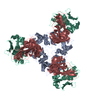
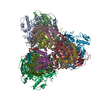
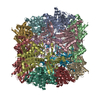
 PDBj
PDBj
